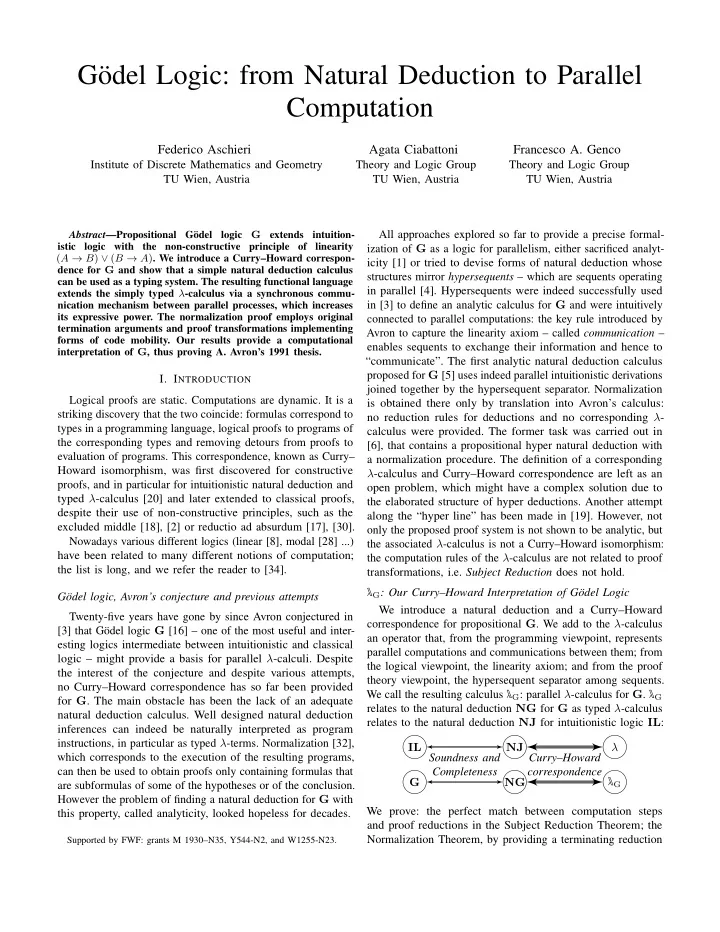

G¨ odel Logic: from Natural Deduction to Parallel Computation Federico Aschieri Agata Ciabattoni Francesco A. Genco Institute of Discrete Mathematics and Geometry Theory and Logic Group Theory and Logic Group TU Wien, Austria TU Wien, Austria TU Wien, Austria All approaches explored so far to provide a precise formal- Abstract —Propositional G¨ odel logic G extends intuition- istic logic with the non-constructive principle of linearity ization of G as a logic for parallelism, either sacrificed analyt- ( A → B ) ∨ ( B → A ) . We introduce a Curry–Howard correspon- icity [ 1 ] or tried to devise forms of natural deduction whose dence for G and show that a simple natural deduction calculus structures mirror hypersequents – which are sequents operating can be used as a typing system. The resulting functional language in parallel [ 4 ]. Hypersequents were indeed successfully used extends the simply typed λ -calculus via a synchronous commu- nication mechanism between parallel processes, which increases in [ 3 ] to define an analytic calculus for G and were intuitively its expressive power. The normalization proof employs original connected to parallel computations: the key rule introduced by termination arguments and proof transformations implementing Avron to capture the linearity axiom – called communication – forms of code mobility. Our results provide a computational enables sequents to exchange their information and hence to interpretation of G , thus proving A. Avron’s 1991 thesis. “communicate”. The first analytic natural deduction calculus proposed for G [ 5 ] uses indeed parallel intuitionistic derivations I. I NTRODUCTION joined together by the hypersequent separator. Normalization Logical proofs are static. Computations are dynamic. It is a is obtained there only by translation into Avron’s calculus: striking discovery that the two coincide: formulas correspond to no reduction rules for deductions and no corresponding λ - types in a programming language, logical proofs to programs of calculus were provided. The former task was carried out in the corresponding types and removing detours from proofs to [ 6 ], that contains a propositional hyper natural deduction with evaluation of programs. This correspondence, known as Curry– a normalization procedure. The definition of a corresponding Howard isomorphism, was first discovered for constructive λ -calculus and Curry–Howard correspondence are left as an proofs, and in particular for intuitionistic natural deduction and open problem, which might have a complex solution due to typed λ -calculus [ 20 ] and later extended to classical proofs, the elaborated structure of hyper deductions. Another attempt despite their use of non-constructive principles, such as the along the “hyper line” has been made in [ 19 ]. However, not excluded middle [ 18 ], [ 2 ] or reductio ad absurdum [ 17 ], [ 30 ]. only the proposed proof system is not shown to be analytic, but Nowadays various different logics (linear [ 8 ], modal [ 28 ] ...) the associated λ -calculus is not a Curry–Howard isomorphism: have been related to many different notions of computation; the computation rules of the λ -calculus are not related to proof the list is long, and we refer the reader to [34]. transformations, i.e. Subject Reduction does not hold. λ G : Our Curry–Howard Interpretation of G¨ odel Logic G¨ odel logic, Avron’s conjecture and previous attempts We introduce a natural deduction and a Curry–Howard Twenty-five years have gone by since Avron conjectured in correspondence for propositional G . We add to the λ -calculus [ 3 ] that G ¨ odel logic G [ 16 ] – one of the most useful and inter- an operator that, from the programming viewpoint, represents esting logics intermediate between intuitionistic and classical parallel computations and communications between them; from logic – might provide a basis for parallel λ -calculi. Despite the logical viewpoint, the linearity axiom; and from the proof the interest of the conjecture and despite various attempts, theory viewpoint, the hypersequent separator among sequents. no Curry–Howard correspondence has so far been provided We call the resulting calculus λ G : parallel λ -calculus for G . λ G for G . The main obstacle has been the lack of an adequate relates to the natural deduction NG for G as typed λ -calculus natural deduction calculus. Well designed natural deduction relates to the natural deduction NJ for intuitionistic logic IL : inferences can indeed be naturally interpreted as program instructions, in particular as typed λ -terms. Normalization [ 32 ], λ IL NJ which corresponds to the execution of the resulting programs, Soundness and Curry–Howard can then be used to obtain proofs only containing formulas that Completeness correspondence λ G G NG are subformulas of some of the hypotheses or of the conclusion. However the problem of finding a natural deduction for G with We prove: the perfect match between computation steps this property, called analyticity, looked hopeless for decades. and proof reductions in the Subject Reduction Theorem; the Normalization Theorem, by providing a terminating reduction Supported by FWF: grants M 1930–N35, Y544-N2, and W1255-N23.
Recommend
More recommend